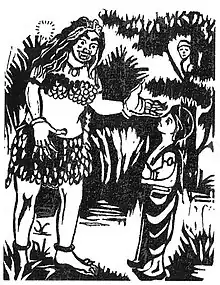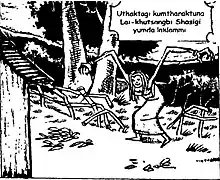 A typical hingchabi of Meitei Manipuri folklore | |
| Grouping | Mythology |
|---|---|
| Sub grouping | Meitei mythology (Manipuri mythology) |
| Similar entities | Helloi, Lam Lai, Umang Lai, Keibu Keioiba |
| Family | demoness |
| Folklore | Meitei folklore (Manipuri folklore) |
| Other name(s) | Hingchapi, Sha hingchabi, Saa hingchabi |
| Country | India |
| Region | Manipur |

Lai Khutshangbi, a popular Hingchabi.
A Hingchabi (Meitei: ꯍꯤꯡꯆꯥꯕꯤ, Old Manipuri: ꯍꯤꯡꯆꯥꯄꯤ, romanized: hing-chaa-pee, lit. 'giantess'[1]) is a mythical creature in Meitei mythology, folklore and religion (Sanamahism) of Antique Kangleipak (Ancient Manipur). She has characters similar to those of the vampires[1] as well as the witches.[2][3] The terms, "hing" means "raw" and "chaa" means "to eat" in Meitei language (Manipuri language).[1]
Sources
- Chaudhury, Sukant Kumar (2006). Culture, Ecology, and Sustainable Development. Mittal Publications. p. 145. ISBN 978-81-8324-132-8.
- South Asian Anthropologist. Sarat Chandra Roy Institute of Anthropological Studies. 1994.
- Singh, Moirangthem Kirti (1998). Recent Researches in Oriental Indological Studies: Including Meiteilogy. Parimal Publications.
- The Anthropologist: International Journal of Contemporary and Applied Studies of Man. Kamla-Raj Enterprises. 2003.
References
- 1 2 3 Singh, Moirangthem Kirti (1998). Recent Researches in Oriental Indological Studies: Including Meiteilogy. Parimal Publications.
- ↑ South Asian Anthropologist. Sarat Chandra Roy Institute of Anthropological Studies. 1994.
- ↑ Parratt, Saroj Nalini (1980). The Religion of Manipur: Beliefs, Rituals, and Historical Development. Firma KLM. ISBN 978-0-8364-0594-1.
This article is issued from Wikipedia. The text is licensed under Creative Commons - Attribution - Sharealike. Additional terms may apply for the media files.
